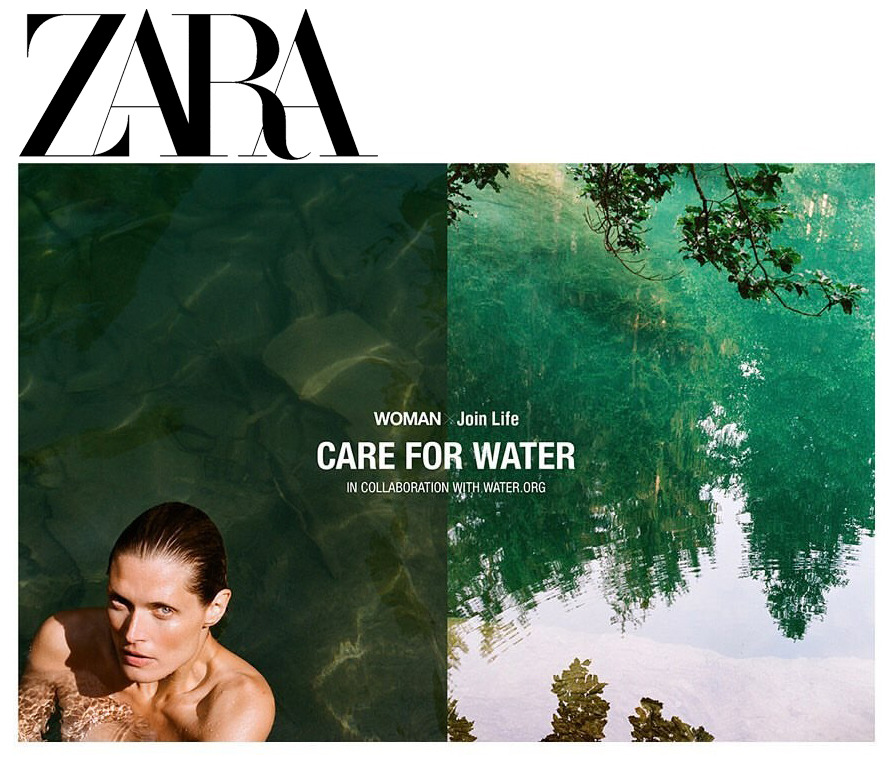Join Life is a new branch of the worldwide known brand Zara, which claims to be questioning their industry practices from the design of the garments to the way they store their product. Through their website, they ensure they are committed to become “better”, in a more environmentally friendly manner. Through their statements, they try to sell their clothes with the commitment of trying to do a real change, and that they are working towards a more sustainable future while they produce fast-fashion clothing. Also, in the image for this analysis, they promote the caring of water, while producing more clothing made from organic cotton, which requires around 660 gallons of water, in contrast with regular cotton that requires 290. ¹
The advertisement in the image is divided in half, although it is unified by the color palette that puts together the whole composition. There is the image of a green deep water with some branches and reflections of the sky in the right side, while the left side has something like the same water but darker, in contrast with a white woman who is facing the camera, looking up at the viewer with intense eyes as she remains in the bottom left corner. The main subject seems to be this person in the bottom, staring at you with a concerned look on her face, even though she seems to be naked in the water for some reason, pretending to be more connected to nature. Still, she does not look different from any model that Zara has used in the past to promote fast fashion and women as valuable due to their appearance. The message Zara is trying to depict here is that they care about water and they are trying to do some efforts in collaboration with an NGO. The image shows that water is connected to nature through the reflection, as well as the woman who stays in the water, trying to show that this is all part of the same environment that works as a system with its plants, water and humans all together.
In an era of fast consumption and the urge of fitting into the fast trends while the world suffers from hyper production and waste, young people, especially women, are most likely to fall for these advertisements. According to Shipra Gupta, the idea of “Multiple selves in evolution” is highly important to young people, and that is what makes fast fashion so successful among this group, which is also composed of consumers around 15 to 29 years of age, being also the group that has more disposable money. ² It is during this stage of their lives that women are looking for their future while also caring for their self-esteem and the world around them, sometimes not because they are conscious about this, but mostly because women are taught in a way that they have developed more empathy than males while also having self-esteem issues: that is when fashion brands pretending to be eco-friendly seem to come in handy. Some studies have shown that in general, women tend to have more commitment towards the environment and tend to consume more eco-friendly products, in contrast to their male counterparts ³, even if it is necessary to pay a higher price for the products that are labeled as environmentally friendly. ⁴
These eco-friendly trends are likely to be successful appealing to this demographic group, and although I do not consider this campaign successful as its message is not clear, I assume the amount of money these brands invest in advertising ends up paying off anyway. In the end, campaigns around the world are more likely to be successful thanks to the amount of money brands invest for advertising than because of the product or service itself.
Bibliography
1. Michela Quartieri, “Sustainability in the fast fashion industry: promotion on social media platforms and consumers’ perception. Zara as a case study”, Università degli Studi di Modena e Reggio Emilia (2019-2020): 104, https://morethesis.unimore.it/theses/available/etd-06152020-091819/unrestricted/Tesi_Michela_Quartieri.pdf.
2. Shipra Gupta, “Evaluating fast fashion: Fast fashion and consumer behaviour”, (2019): 5. https://volago.fr/wp-content/uploads/2022/05/EvaluatingFastFashionExamingitsMicroandMacroPrespective.pdf.
3. D. Costa Pinto et at. “Going green for self or for others? Gender and identity salience effects on sustainable consumption”, International Journal of Consumer Studies, 38 (2014).
https://onlinelibrary.wiley.com/doi/10.1111/ijcs.12114.
4. Bo Zhang et al. “Consumer Attitude towards Sustainability of Fast Fashion Products in the UK”, Sustainability 13(4) (2021). https://www.mdpi.com/2071-1050/13/4/1646.


Sydney Fairlie
The student provides a well-thought out introduction to Zara’s greenwashing antics, as well as any further information needed to fully understand the concept of Zara wanting to “be better” while still running a fast-fashion empire. I appreciate the student taking further action with the critical analysis, as they not only discuss the dangers false advertising can cause, but dives into the psychology behind it all, which would further contribute to the dangers of their advertising.
Zara promoted their new practices to be more environmentally-friendly when it comes to their business through clothing designs and water use. However, Zara resorted to using organic cotton, which requires 660 gallons as opposed to regular cotton, which only uses 290 gallons. Zara emphasizes their “care” for water through the advertisement, as the set of it is in deep green waters for a more natural look. Zara’s deceptive ads have had many consumers fall for their green practices, especially young women, who are finding themselves in a world full of judgement.
The use of scholarly sources in this article has greatly improved the reader’s understanding of the greenwashing in Zara’s ads. The information chosen from these sources gives a deeper connection to the scandal as a whole and really upgraded and refined the writing.
Using statistics of Zara’s greenwashing practices, or supposed green practices, was a great inclusion. I believe adding more background information on Zara’s “green practices”, or more statistics like that of the water used inc cotton, would help give more context for the writing and critiques.